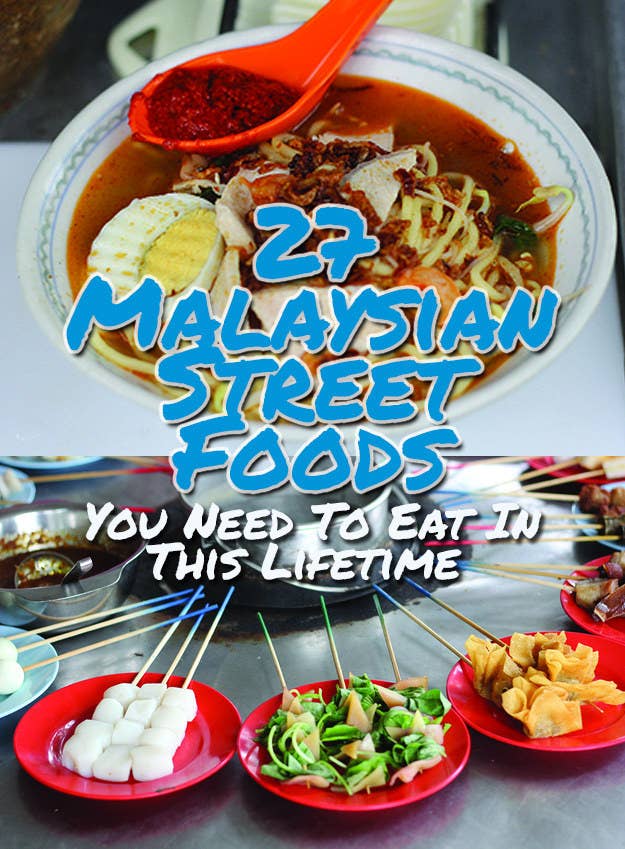
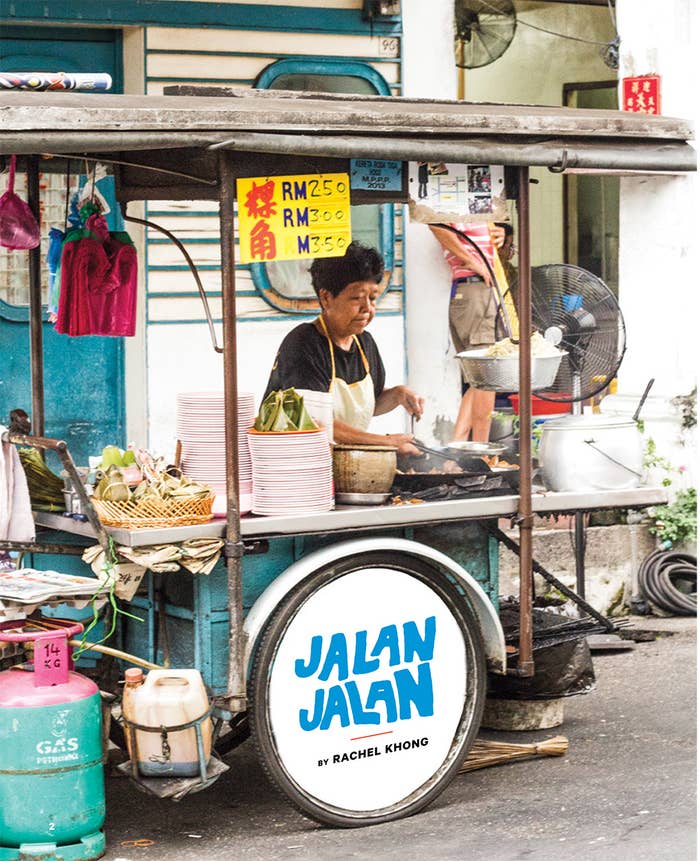
Jalan is what you call a street or road in Malaysia.
You can also say jalan jalan, which is a verb, meaning "to stroll" or "to hang out and have a nice time," and is what my mom says to my dad when she takes his arm and wants to amble around on a nice, clear night.
In Penang, Malaysia, the jalans seem to be paved with food. This both makes sense and doesn't: The temperature hovers at a haunting 80-plus degrees year round, meaning it's too hot to eat inside though it is also, actually, too hot to eat outside. There are cooks everywhere, standing over hot woks and huge broth pots, barking an unfamiliar Chinese dialect (it's Hokkien) while dispatching plate after same-looking plate as though they've been doing it forever—and many of them have.
All food is fast food in Penang: If you're ordering to go, drinks come in plastic bags outfitted with a piece of raffia to hang from the handlebars of your scooter; rice comes in banana leaves or newspaper packets. Noodles are bagged and soups are too. If you're eating "in," you're still eating outside or half outside, and you're expected to eat fast, then go on to eat the next thing — fast. Colorful melamine plates and bowls and chopsticks get washed in huge buckets, and dirty dishwater spills into the streets.
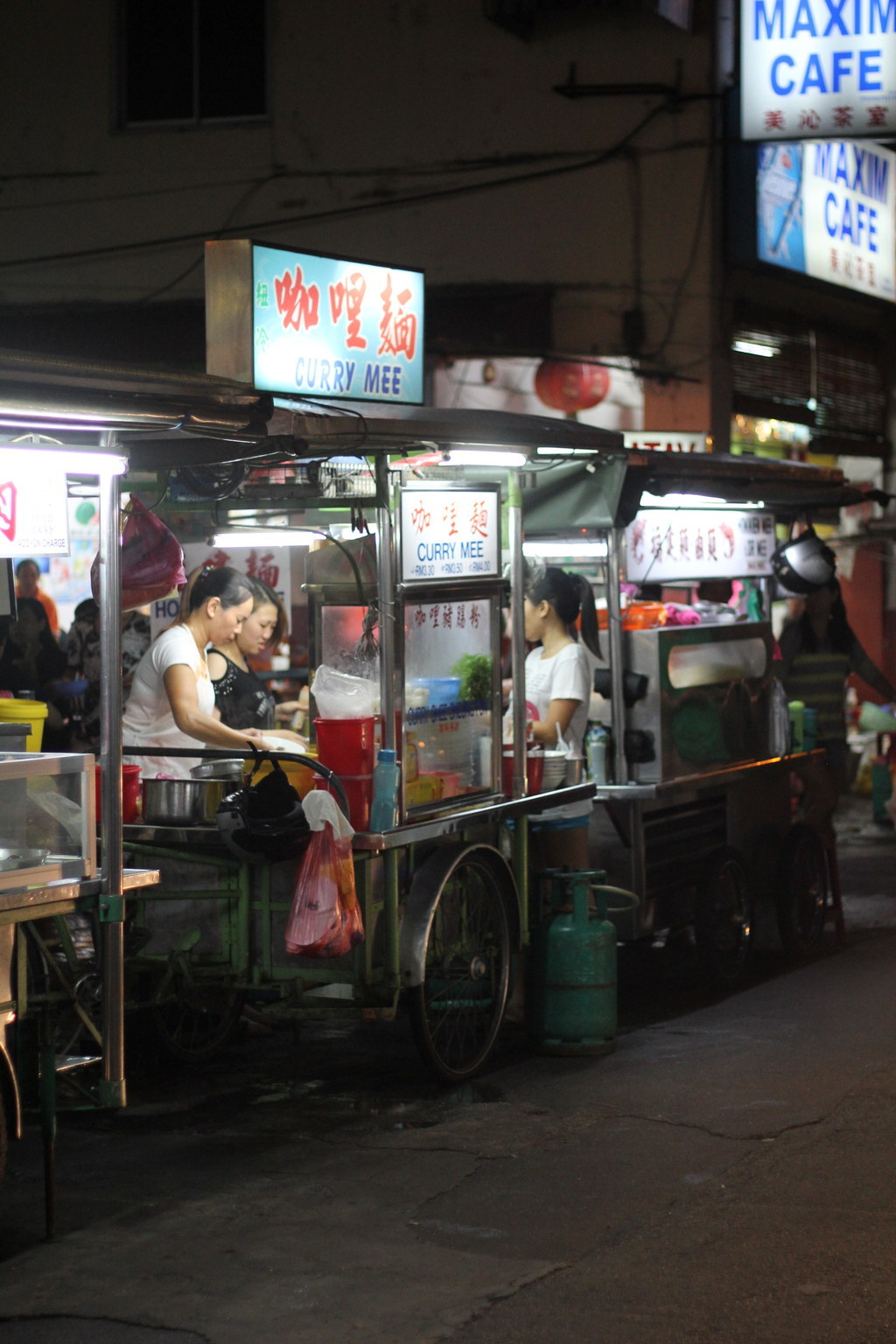
The only rule: Do not fret about where to find "the best."
Street food in Malaysia — and especially in Penang — can be overwhelming: the abundance, the no-nonsense-ness, the speed. There are hawker stalls on small streets, on big streets, hawker centers outside and inside of coffee shops. One comforting fact: the same foods repeat themselves everywhere, reliably. Wherever you are in Penang, you can usually find the entirety of Malaysian street food on offer. The scenarios in which you'll encounter these foods repeat themselves, too. Once you stop fretting about where you'll find the best, you'll begin to see the patterns emerging from the shrimp-paste-covered chaos, and the cornucopian abundance becomes a very enjoyable problem to tackle.
Part I:

After being named a UNESCO World Heritage site in 2008, George Town, in northeast Penang Island, now attracts leggy blonde tourists from Australia and New Zealand who'll be out late at night, drunk al fresco. This does not change the fact that the city is a bunch of falling-apart low-rise buildings that date back to British colonization. The stores always appear to be closed, and the place would be a ghost town if it weren't for the liveliness of the streets and food carts, which are everywhere.
1. Assam Laksa (Rice Noodles in Fishy Soup)

2. Rojak (Fruit and Vegetable Salad)
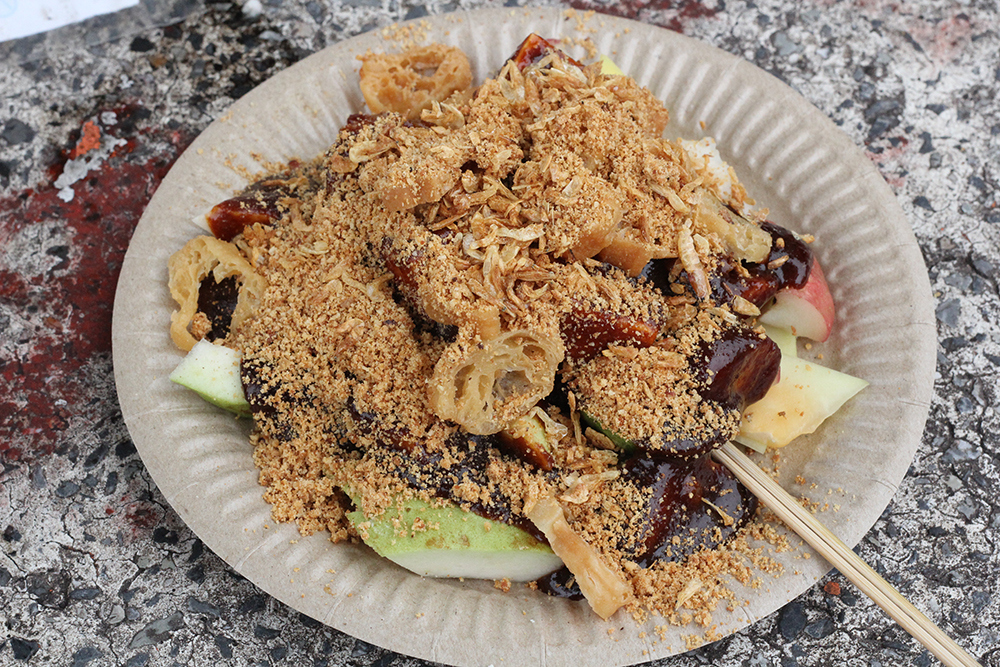
3. Roti Canai (Flatbread)
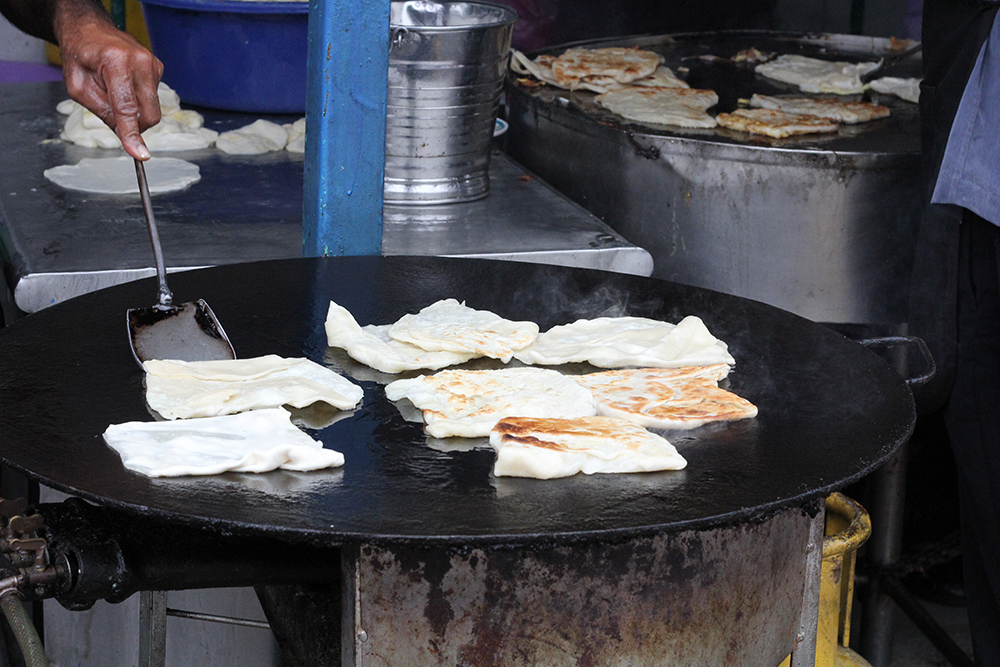
Part II

4. Chendul/Cendol (Cold Dessert Soup)
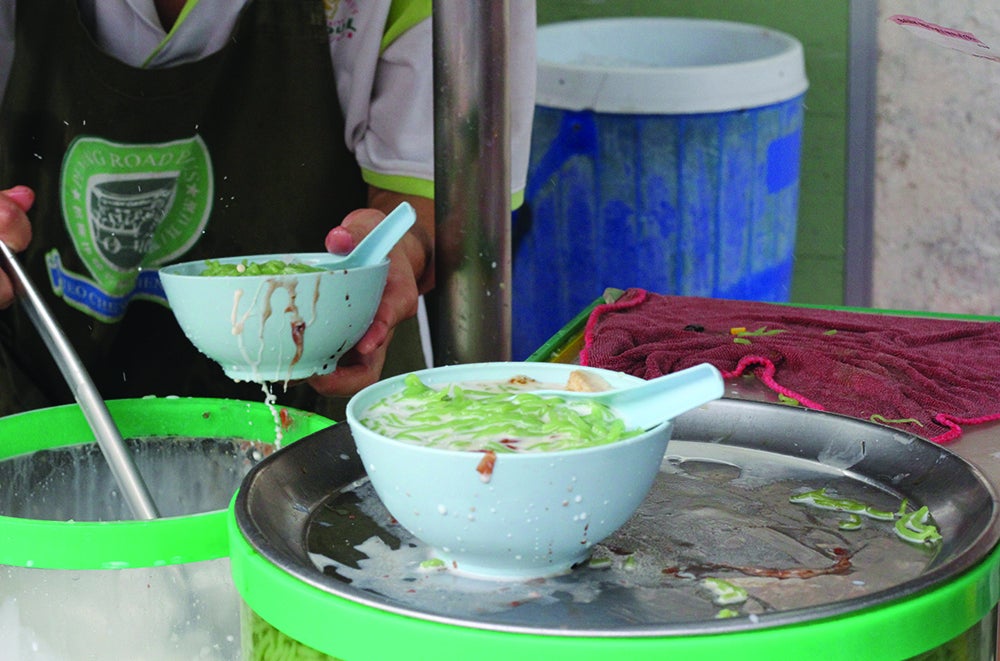

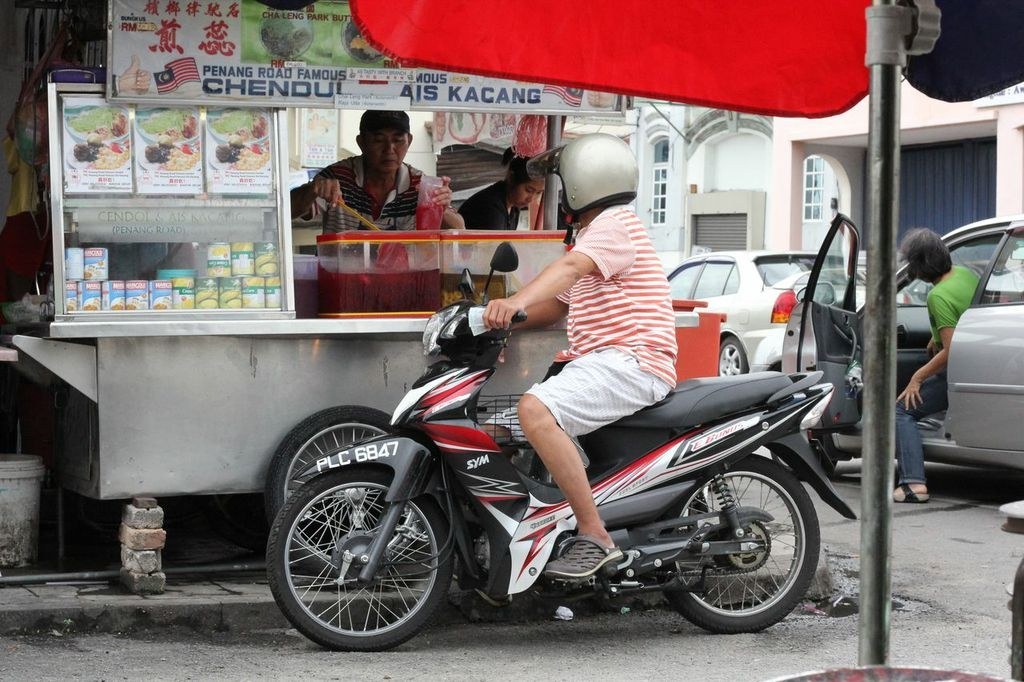
You can find chendul/cendol, a sort of cold dessert soup, on Penang Road, a tiny road just large enough for a single car to drive slowly through. Chendul refers to the green Jello-ish squiggles, made from mung-bean flour and stained green with pandan, the leaves of a tropical plant that taste sort of like vanilla. The squiggles, along with red beans, float in a soup of santan, coconut milk, and palm sugar. The soup is ladled over a big lump of ice, and condensed milk goes all over that. It's served with a spoon but the spoon is unnecessary.
Where: This stall is Penang Road Famous Teochew Chendul. 27 & 29, Lebuh Keng Kwee, George Town, Penang. Mon-Fri, 10.30am-7pm; Sat & Sun, 10am-7.30pm. More info here and here.
5. Apom Balik (Stuffed Pancake)
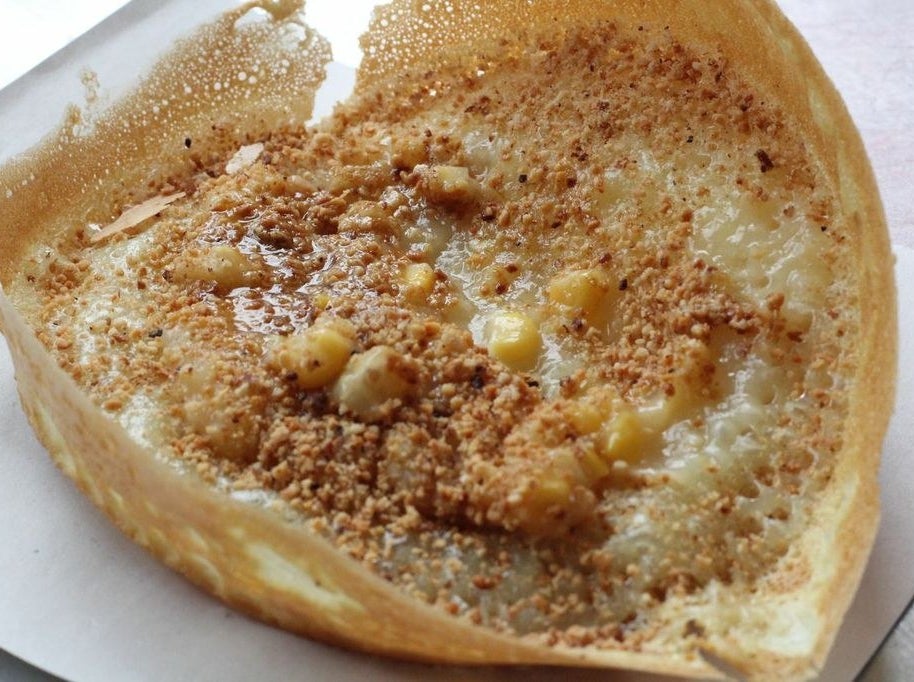
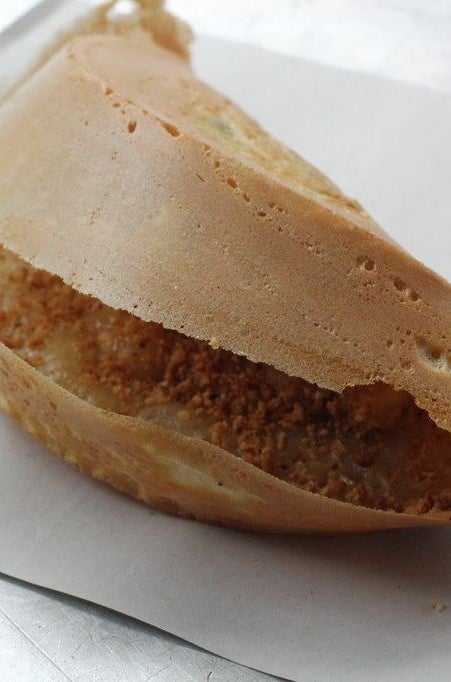

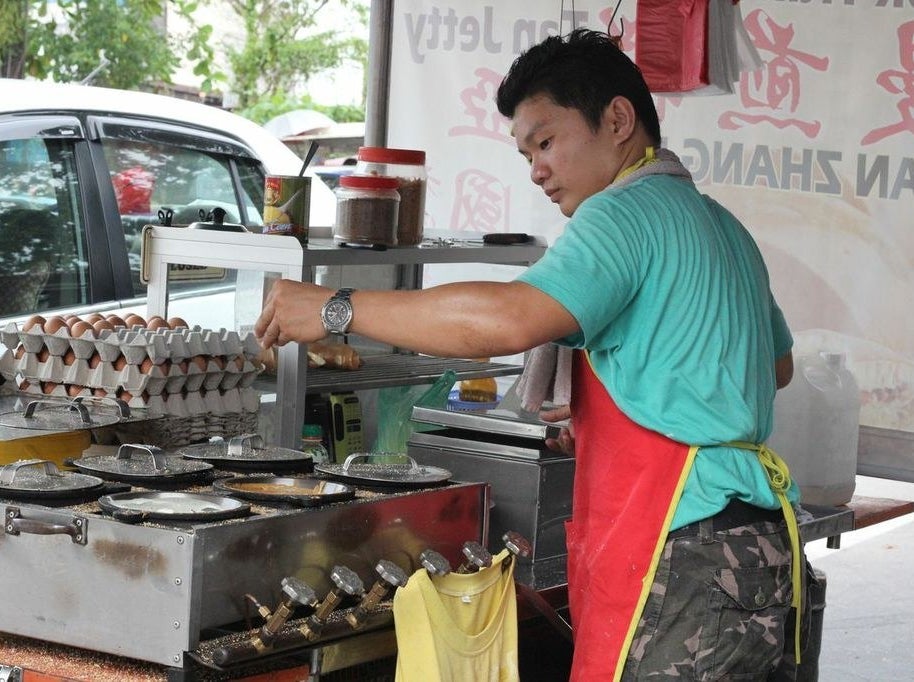
Apom balik is a sticky rice-flour pancake with creamed corn(!) inside. This vendor at Tan Jetty spoons corn straight from the can into the cooking batter—eggy and fluffy—then deftly extricates the whole thing and folds it over like a loose taco, a shape that makes it possible to get both crispy edge and sticky interior in a single bite.
Where: This stall was at Tan Jetty.
6. Batu Maung Satay (Grilled Meat on Skewers)

7. Koay Chiap (Duck and Noodle Soup)
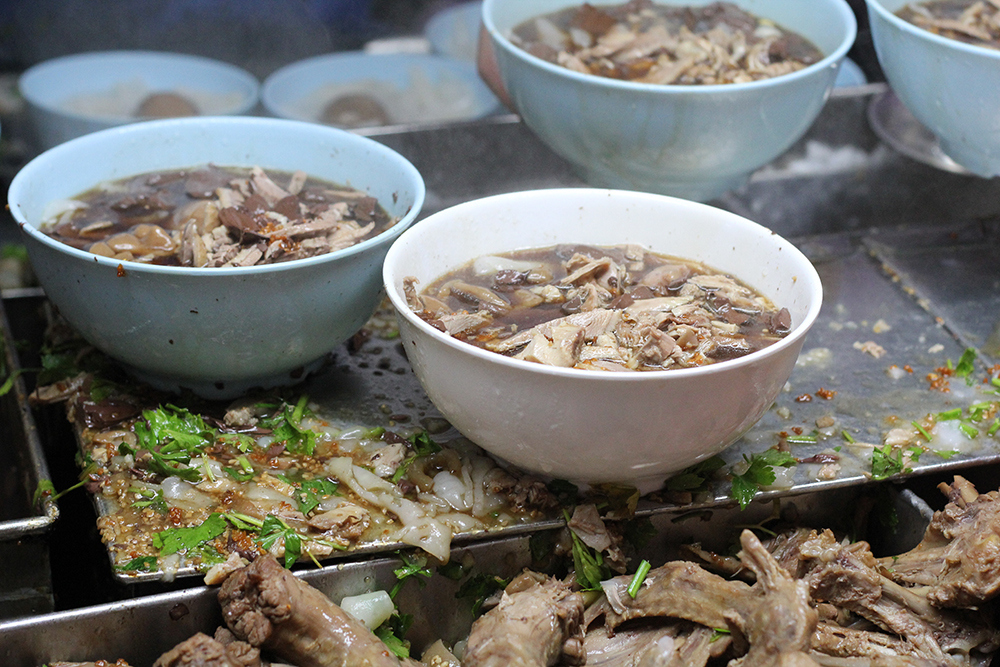
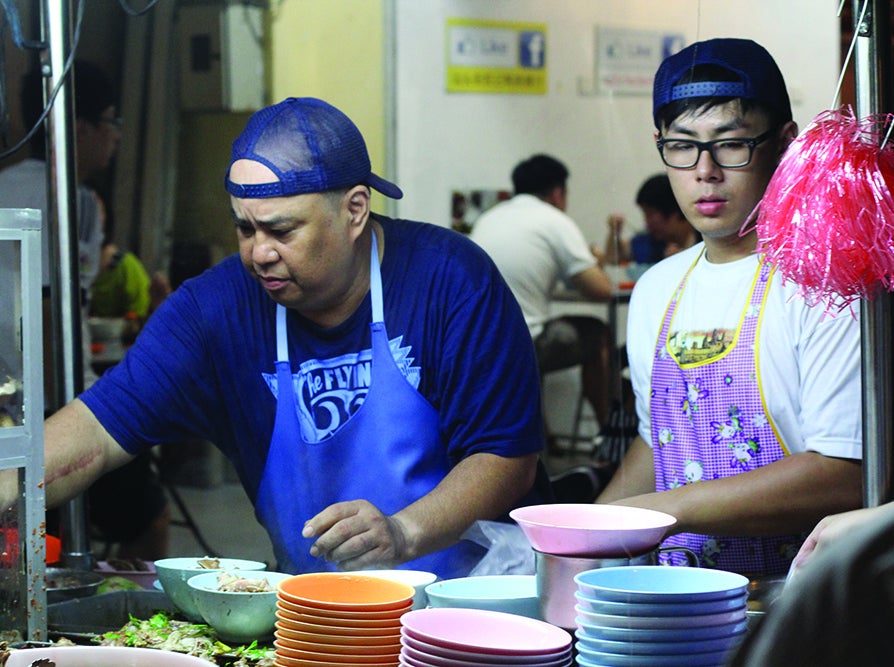
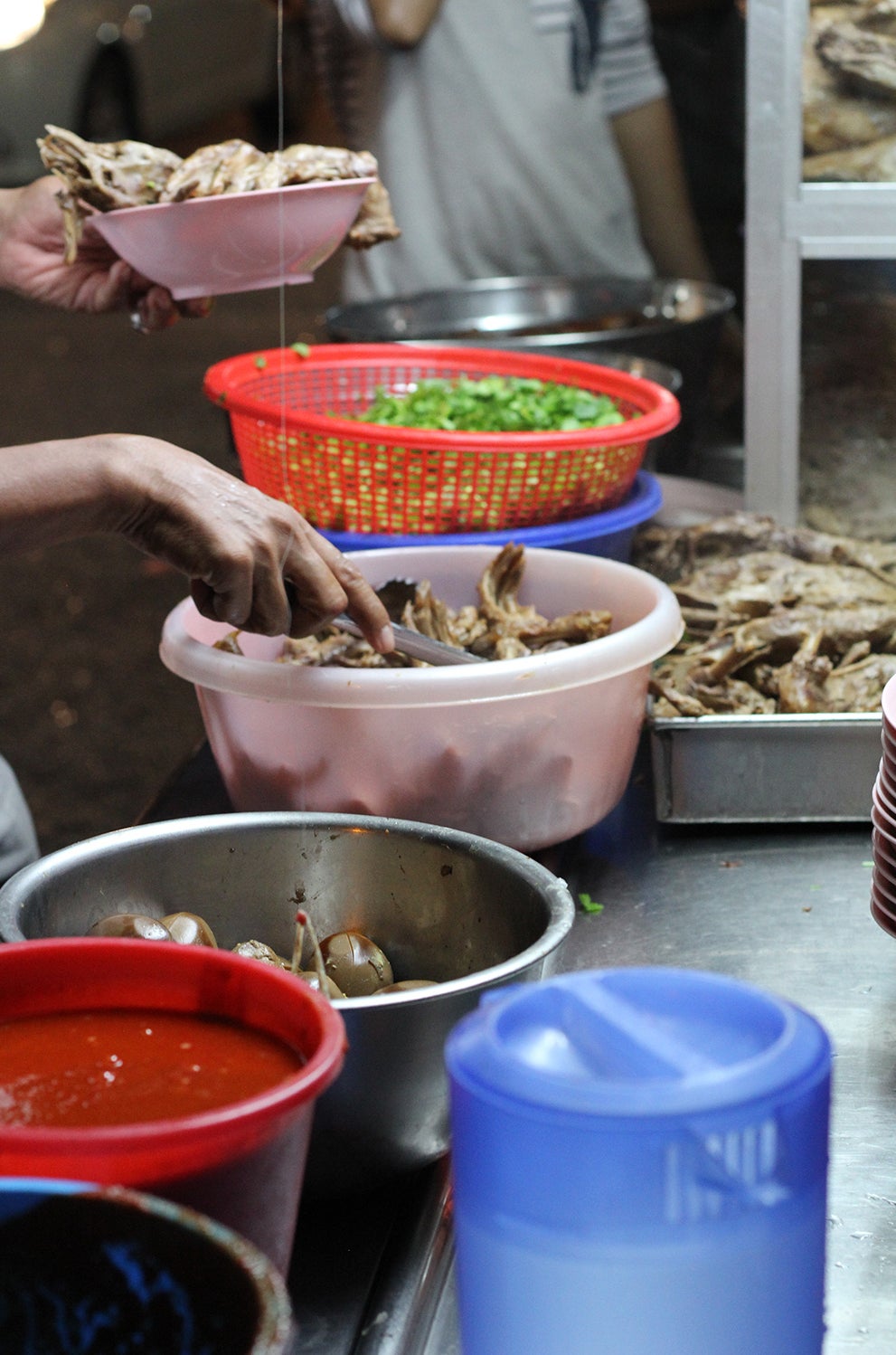
Kimberly Street is sleepy in the daytime but, like the nocturnal stink badger of western Malaysia, active at night. The most bustle surrounds two dudes in backward hats and aprons at a stand dishing out koay chiap, an offal-y dark soup of duck meat shreds, gizzards, coagulated blood, a soy-sauce-boiled egg, and curled-up scrolls of rice noodles. Chinese celery bits imbue a nice herbiness.
Where: Kimberly Street at night.
Part III:

The NO OUTSIDE FOOD OR DRINK rule is reversed in cafés, kopi tiams, in Malaysia. You're supposed to collect your food from the stalls outside; the coffee shop itself provides seating, drinks, and cigarettes. The arrangement is mutually beneficial to both shop owner and hawkers: the coffee shop collects rent from the vendors and benefits from extra customers, while the hawkers benefit from the centralized destination for foot traffic, and in most cases get to store their carts in the place overnight, rather than having to push them home. The vendors outside Sin Seow Fong Lye Café on Macalister Lane mostly peddle noodles.
8. Chee Cheong Fun (Rice-Noodle Rolls)
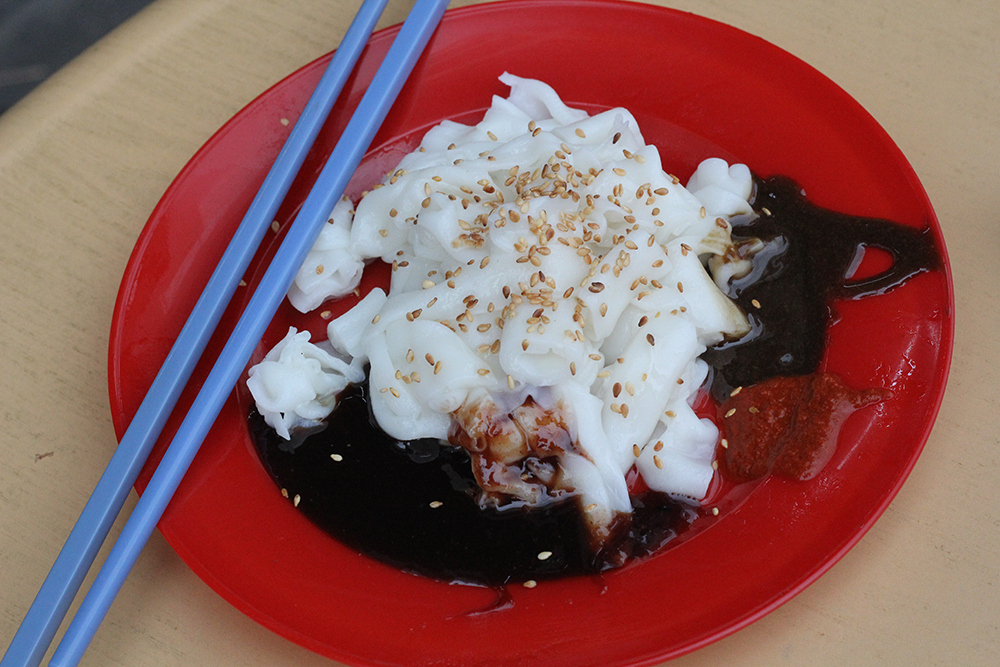
9. Café Drinks: Nescafé and Milo (Coffee and Chocolate Malted Beverage)
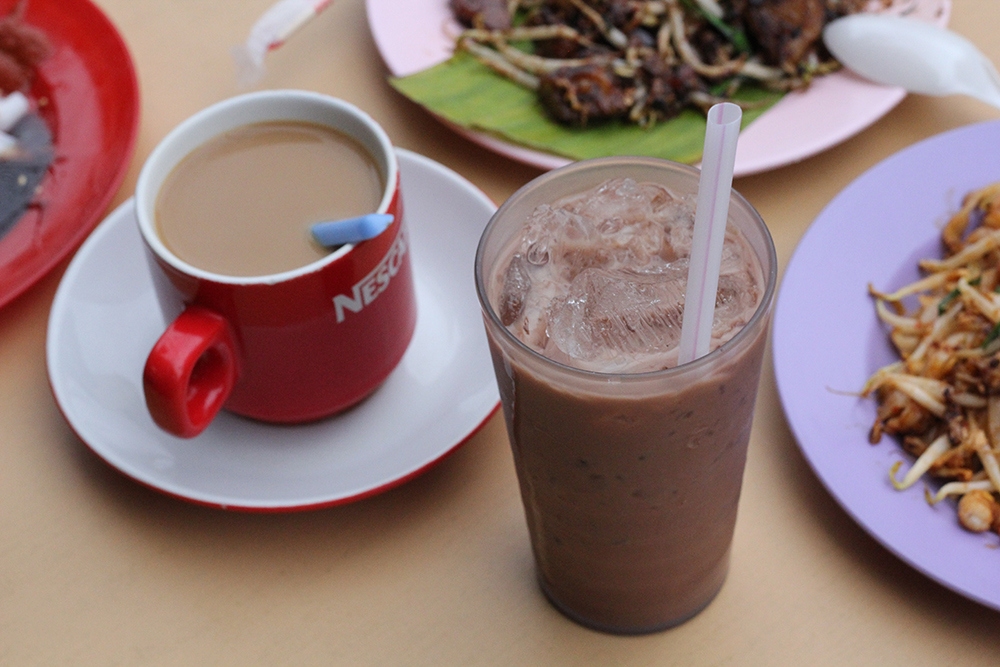
10. Teh Tarik (Pulled Tea)

Part IV:
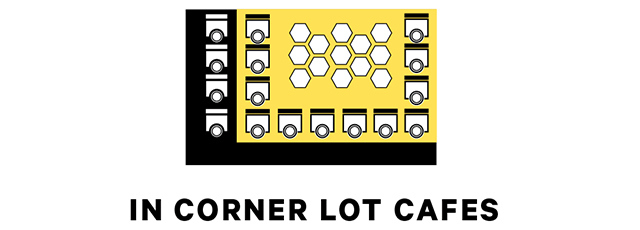
11. Koay Teow Th'ng (Sweet Noodle Soup with Meat and Fish Balls)
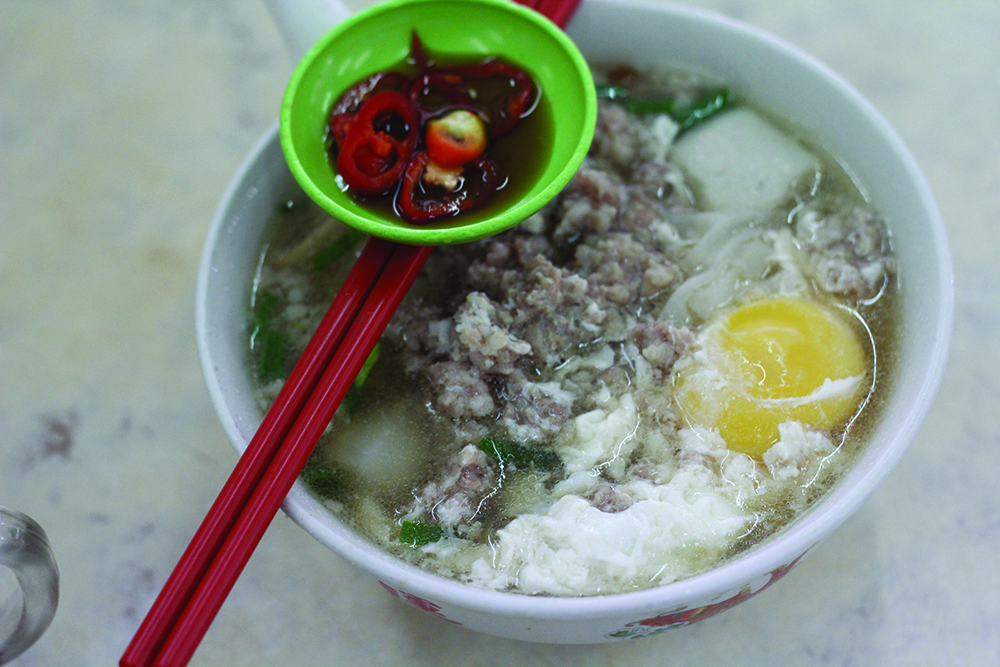

12. Lok Lok (Hot Pot)

13. Ice Kacang (Corn-Bean Frozen Dessert)
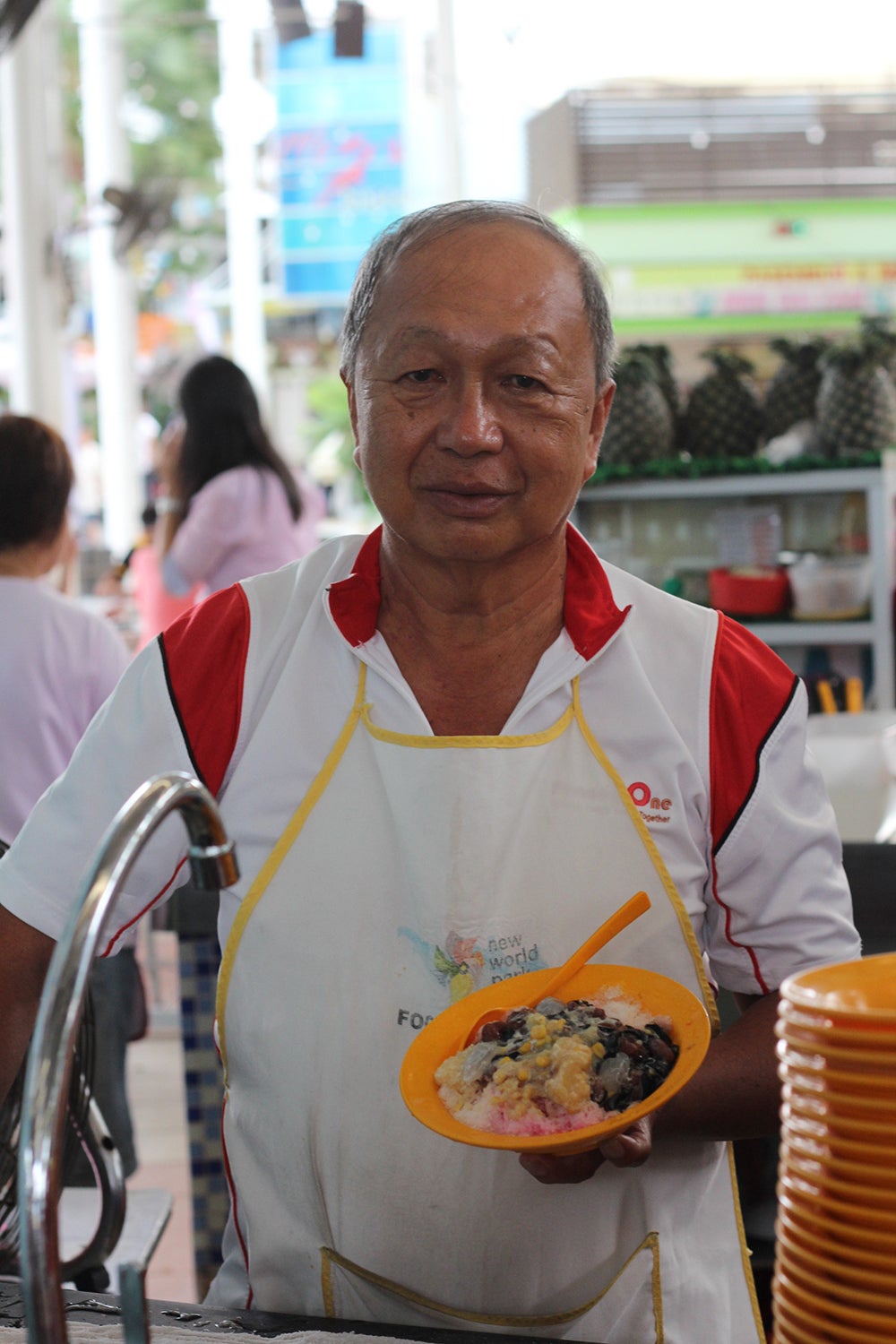
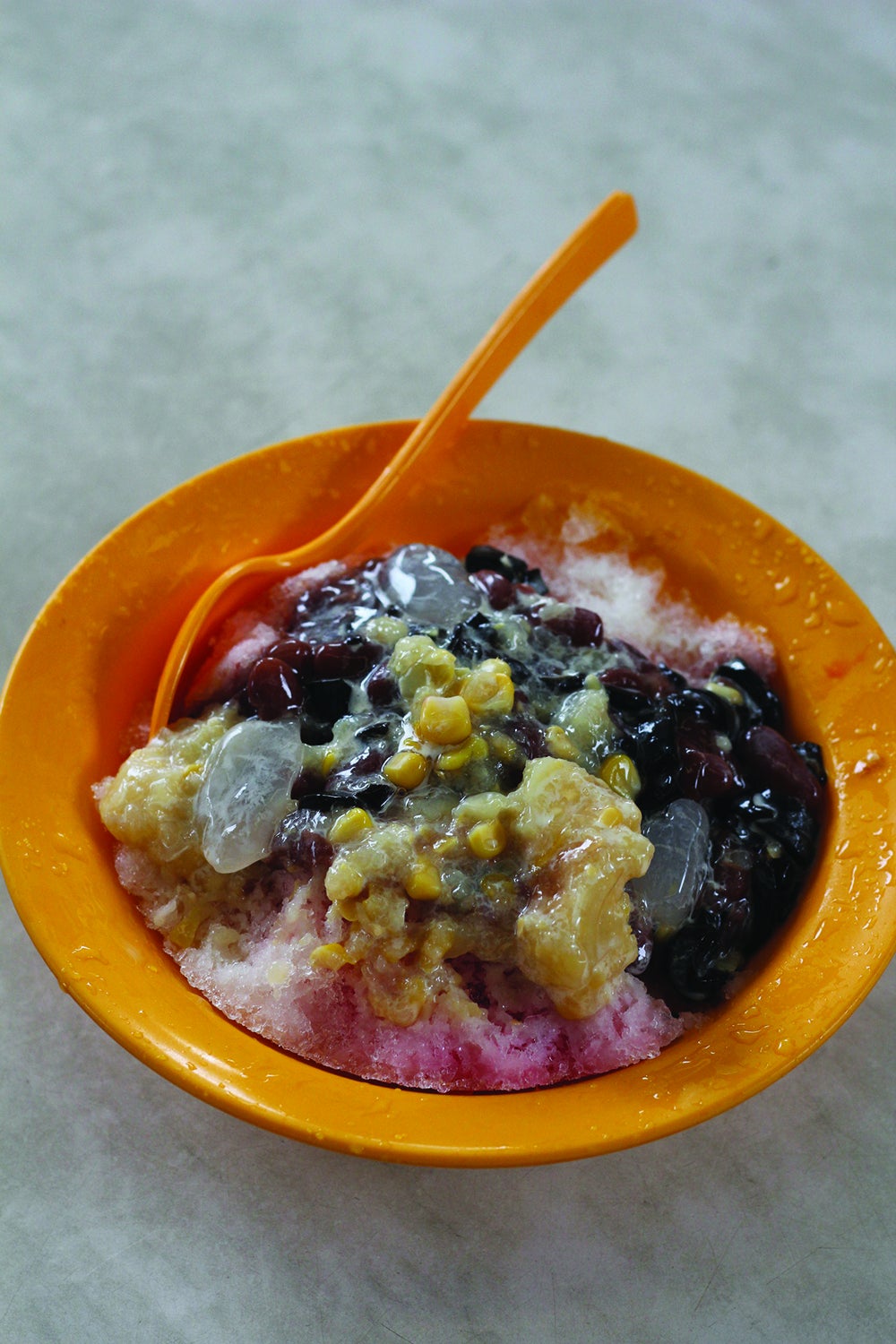
New World Park is a newish hawker center off Swatow Lane. Because there’s too much traffic for tiny Penang, the government is taking Singapore’s lead and trying to move vendors to covered hawker centers. A lot of the hawkers who used to sell outside on Swatow Lane were moved to New World Park. The center resembles a mall food court: stations with clean chopsticks, a place to stack your trays, and standardized signage that tells you, plainly, who’s selling what.
Lee Eng Lai is sixty-three and sells ice kacang here. His family has sold ice kacang on Swatow Lane since 1923; they relocated to New World Park when it opened in 2008. The recipe is the same as it always was, but now they have an electric ice-shaving machine. Ice kacang is kind of like a banana split, but in place of bananas there’s corn, kidney beans, and mysterious translucent toothsome jellies. And instead of ice cream there’s shaved ice, topped with a pink syrup that just tastes pink, not in a synesthetic way, but like you’d imagine — like bubble gum. And there’s also, of course, condensed milk all over everything. If you want to gild the kacang, you can add a scoop of ice cream on top of all that.
Where: New World Park hawker center off Swatow Lane.
Part VI:

14. Durians
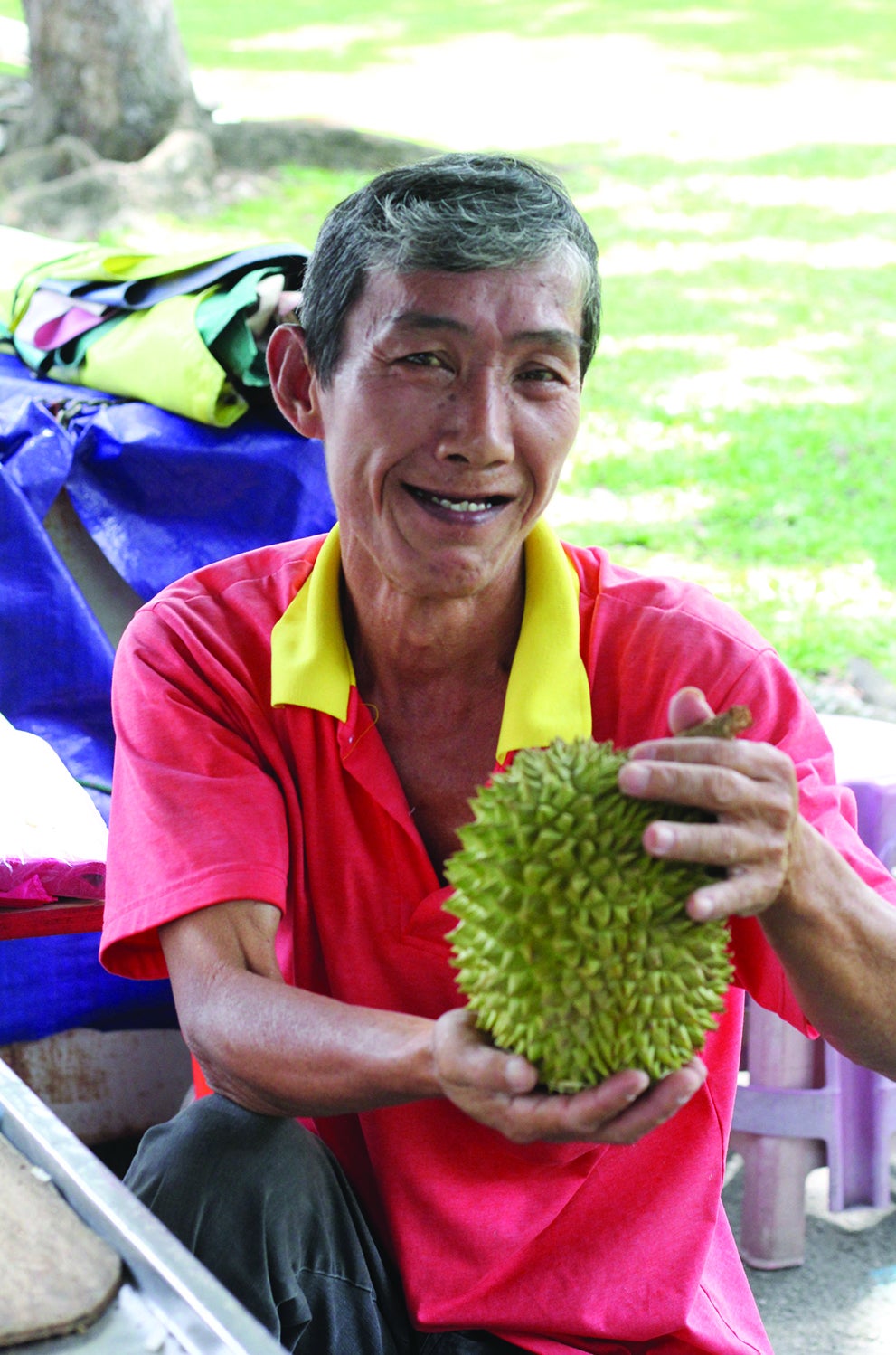
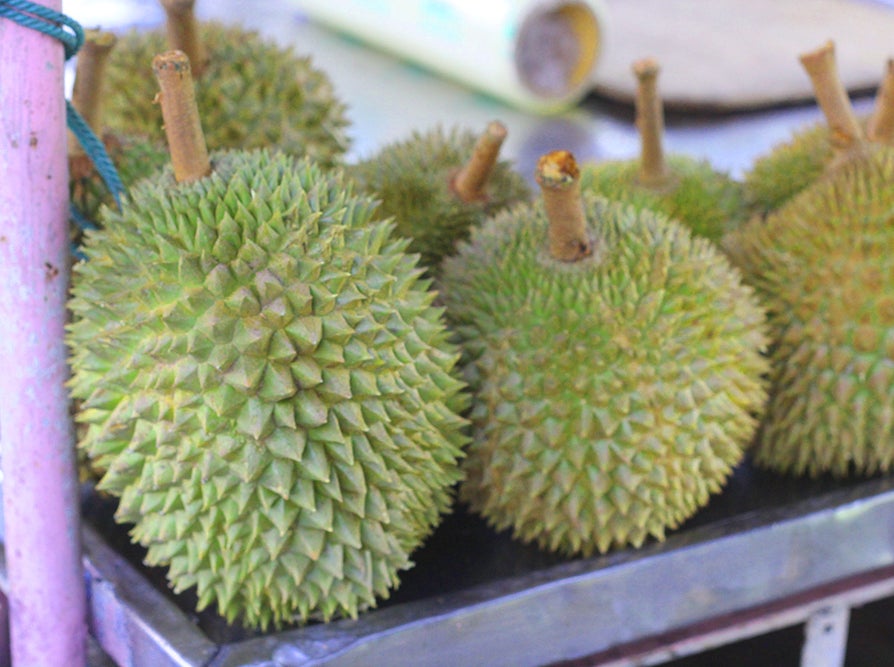
Durians are surrounded by fantastical lore. Durians never fall on people’s heads because they have EYES. You must not eat durians and drink alcohol because you’ll DIE. Drinking salt water using the durian’s shell as a cup is how you prevent smelly burps.
There are two durian seasons in Malaysia, June and December, and when the fruit’s in season, Chan Eng Kean, 54, sells local specimens from Penang Hill, in Balik Pulau. He goes to his distributor in the morning; when he gets back to Jalan Pantai Jerjak, he sells durian from eleven a.m. to five p.m. He’s been selling fruit all his life, but only selling durian for three years on this street. It’s popular, but he told me that he doesn’t particularly like eating it.
Where: Jalan Pantai Jerjak 13 (see map above).
15. Nasi Lemak (Rice Cooked in Coconut Milk)

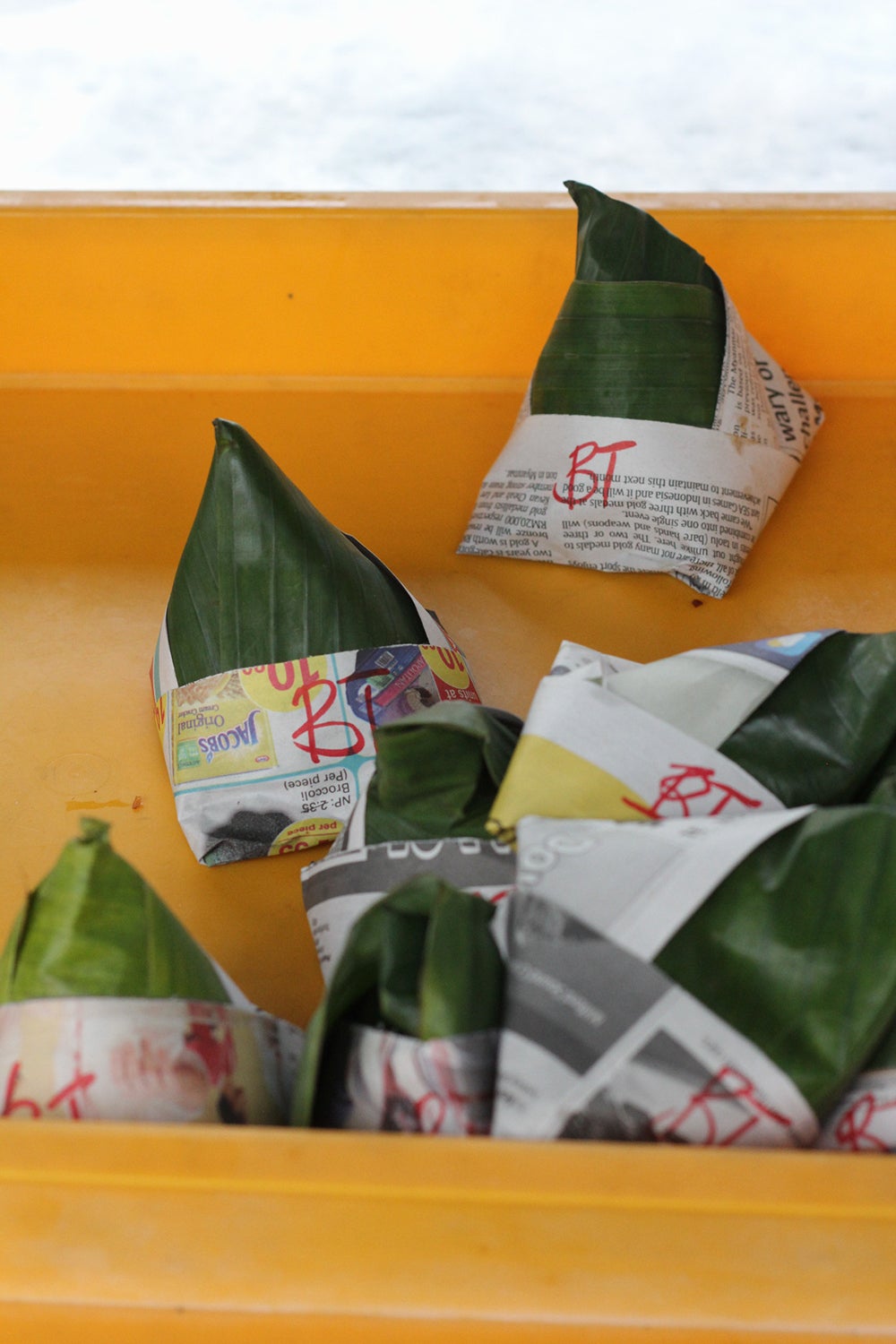
Lim Gaik Nai, 56, is a mother of four who’s been selling chee cheong fun, nasi lemak, and other snacks here for about five or six years (before this, she used to have a pig farm). Nasi lemak is a Malaysian breakfast dish that comes wrapped up in a banana-leaf package: fried anchovies in shrimp paste and chili sauce, with rice cooked in coconut milk, a hard-boiled egg, cucumbers. She doesn’t make what she sells; she gathers the components from distributors and steams the things that need steaming before serving.
Where: Jalan Pantai Jerjak 13 (see map above).
16. Char Kuey Teow (Stir-Fried Noodles)
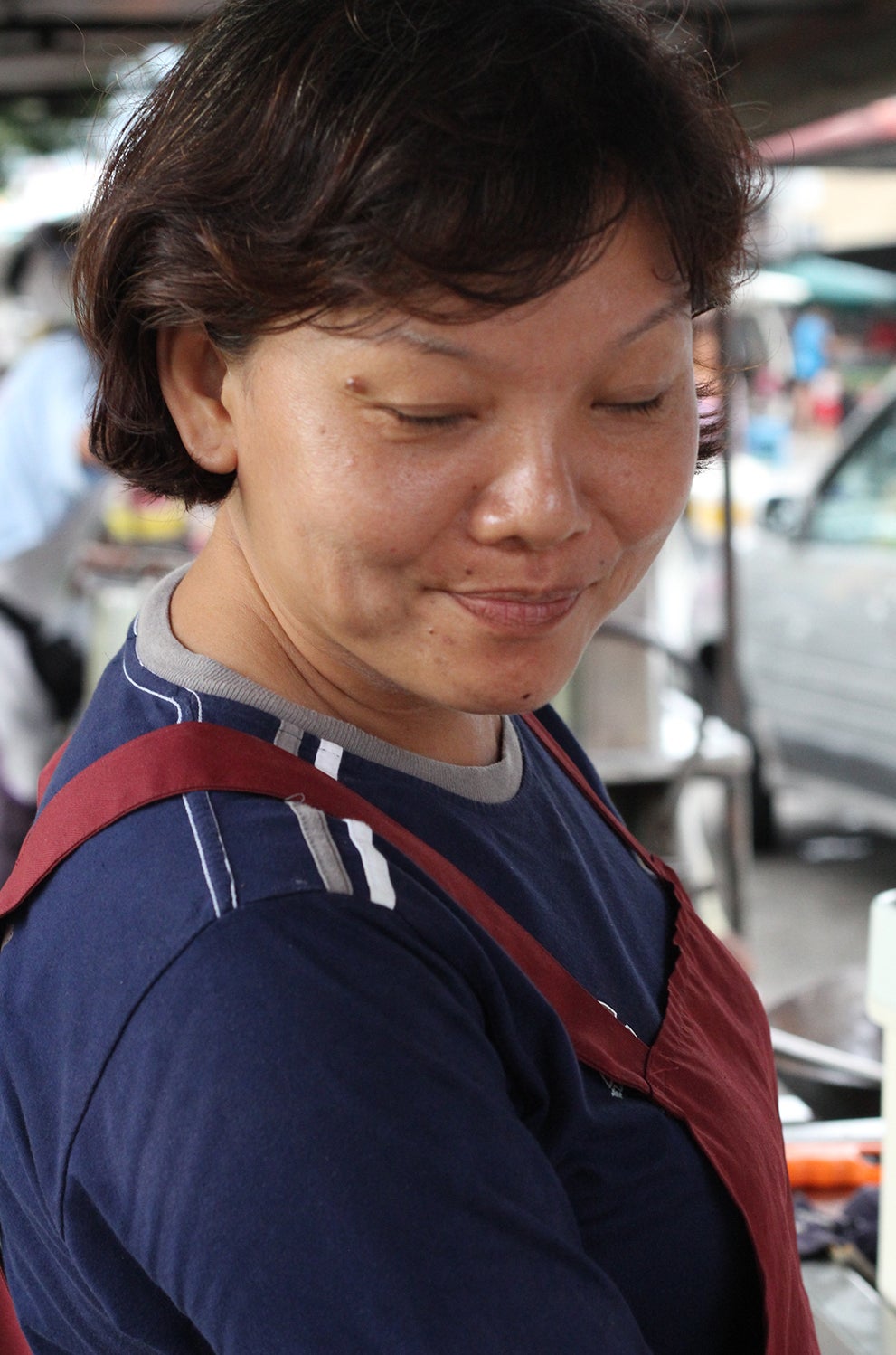
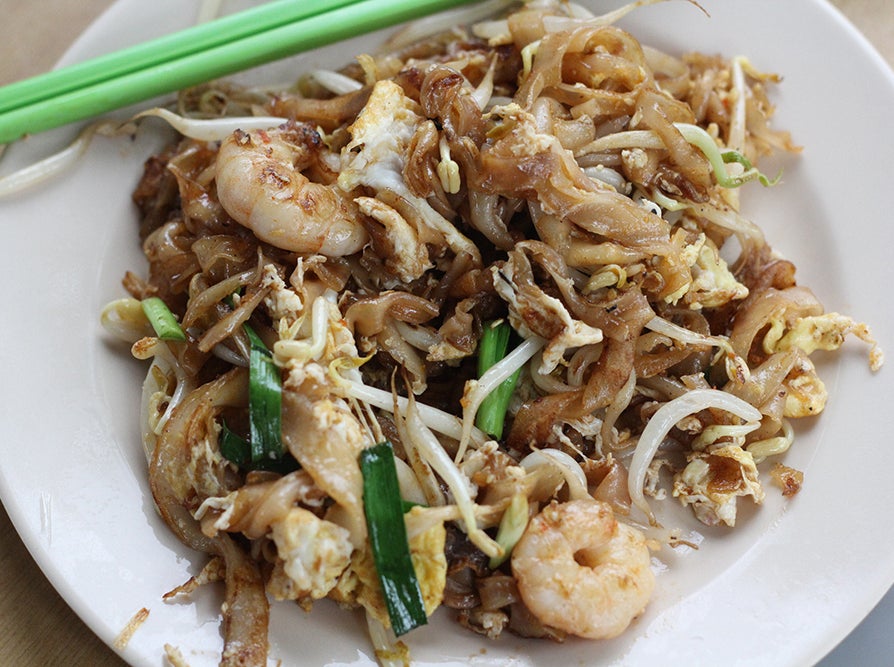
Lai Saw Giak, 46, has been selling char kuey teow here for five years. For about one U.S. dollar you get a plate of thin, delicate, spicy-salty noodles cooked in lard and topped with eggs, prawns, cockles, chives, and bean sprouts. She buys her noodles from a noodle man who visits every morning; most of the other noodle vendors on this street do, too. Lai used to be a housewife, but her friends liked her cooking and encouraged her to set up shop. Somebody else had been selling char kuey teow on Jalan Pantai Jerjak before her, and when that hawker left, the café owners asked if she’d replace him. That’s how it goes here: you can’t just show up and set up your cart (duplicate carts—two char kuey teow carts, for example—aren’t allowed); you have to be asked. She gets here at five forty-five in the morning with lots already prepped, including prawns peeled and sauce concocted; she sells until four thirty p.m. and is done cleaning up by six thirty.
Where: Jalan Pantai Jerjak 13 (see map above).
17. Hokkien Mee (Egg and Rice Noodles in Spicy Soup)
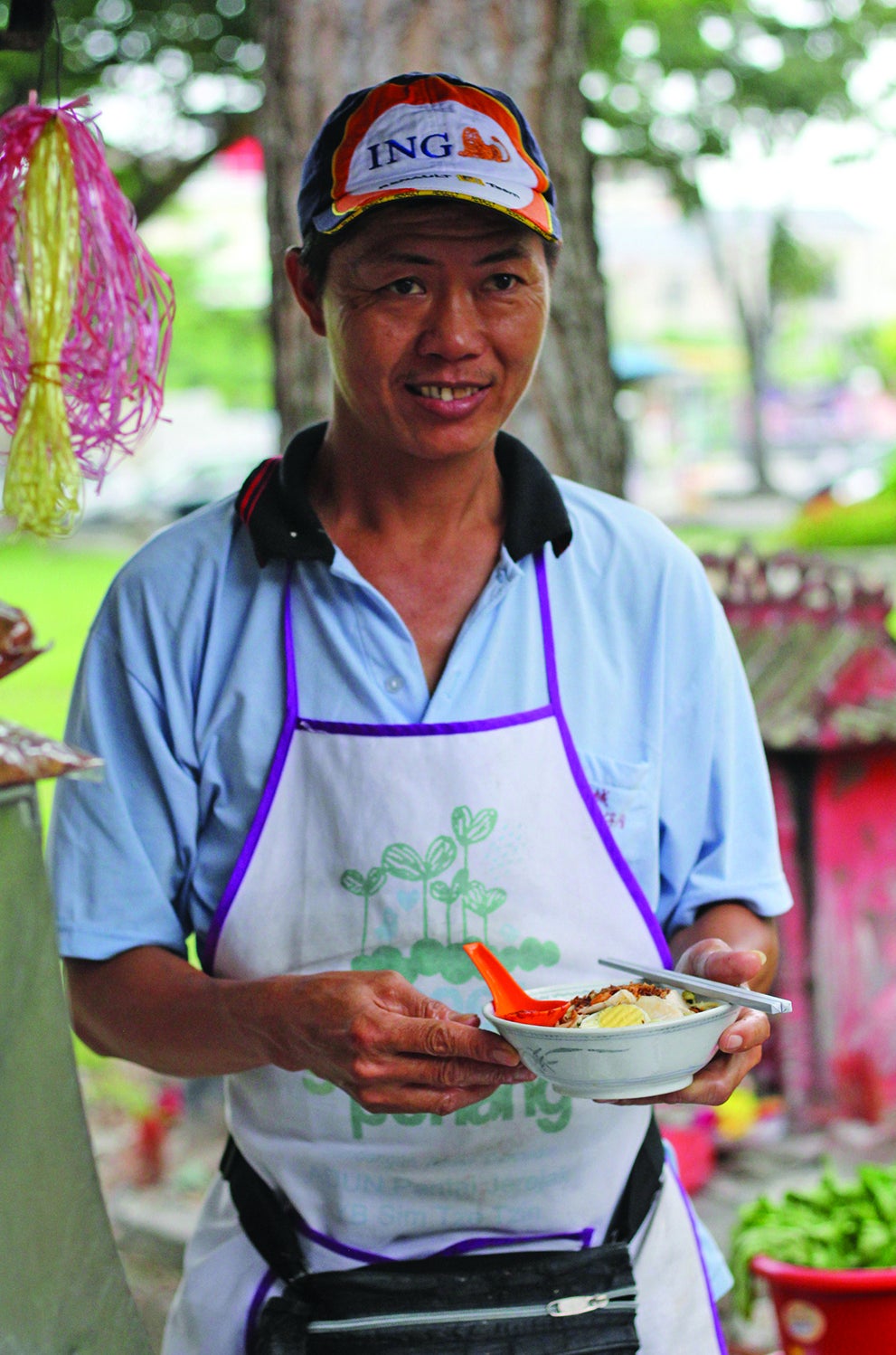
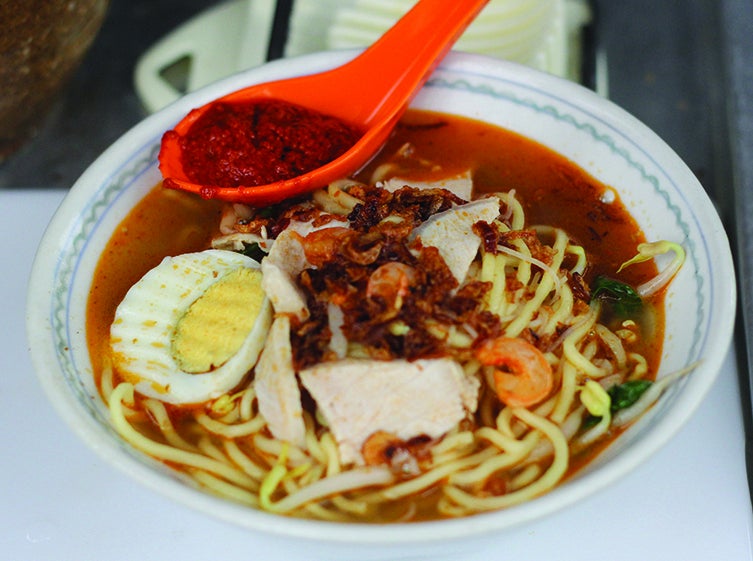
At six thirty in the morning, Oon Aik Lam, 48, arrives to sell hokkien mee (also known as ha mee). Two kinds of noodles go into a bowl of broth — egg noodles and rice vermicelli — then kang kong (sometimes called “water spinach” or “hollow-heart vegetable”), prawn halves, bean sprouts, slices of pork, and hard-boiled egg follow. It’s finished with a soup spoon of homemade chili. Oon’s father makes the stock with prawns, salt, sugar, chili, pork bones, and other things he doesn’t know about, he says, because the recipe is secret and his father, who’s been cooking it for more than thirty years, has still never taught him. Oon has one big pot of his dad’s secret broth that he ladles out until it’s gone, then he packs up and pedals away.
Where: Jalan Pantai Jerjak 13 (see map above).
18. Wonton (Wan Tan) Mee (Noodle Soup with Dumplings)

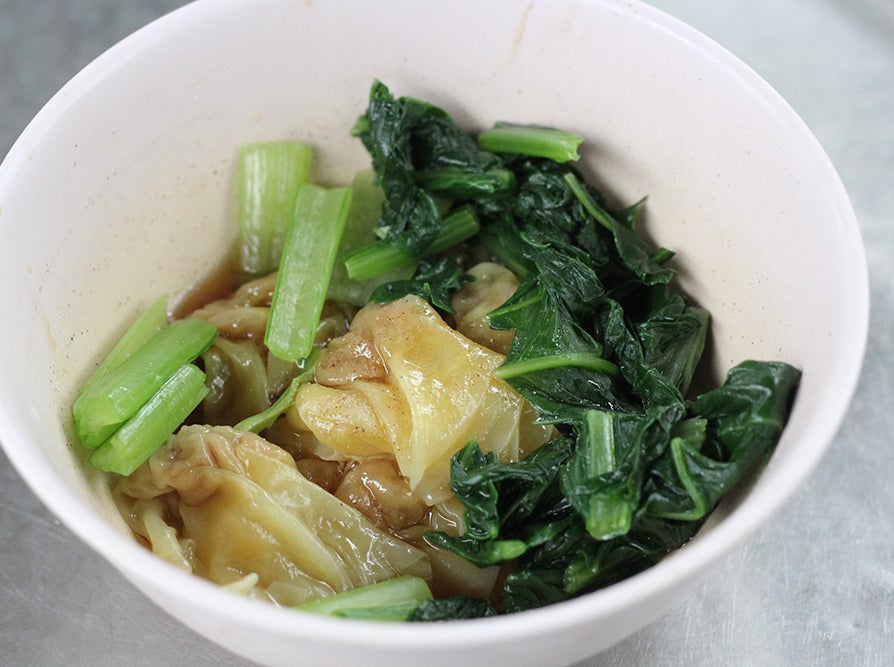
Yap Siew Ean sells wonton mee: noodles tossed in black sauce, served with wontons, and topped with a little bit of a choy and hot pink char siu (roast pork), with pickled chilies on the side. (You can also buy just the wontons: ten wontons in a bowl of pork-bone broth.) She started helping her dad out when she was little — her dad bought the cart she still uses forty-two years ago, when she was born — and learned how to cook from him (he learned from her grandmother). She buys the char siu and noodles ready-made but makes the broth, sauce, pickled chilies, and wontons (pork, shrimp, pepper) herself. She talks about “original” taste — that these noodles are in the same tradition of her father’s. Her family’s been here longer than the owners of the coffee shop and they’ve watched the business change hands. The building itself — with the coffee shop — hasn’t been around forever; before the storefronts and coffee shop existed, she says, her family sold wonton mee from the side of road.
Where: Jalan Pantai Jerjak 13 (see map above).
19. Bak Kua Bread (Dried Pork Subs)
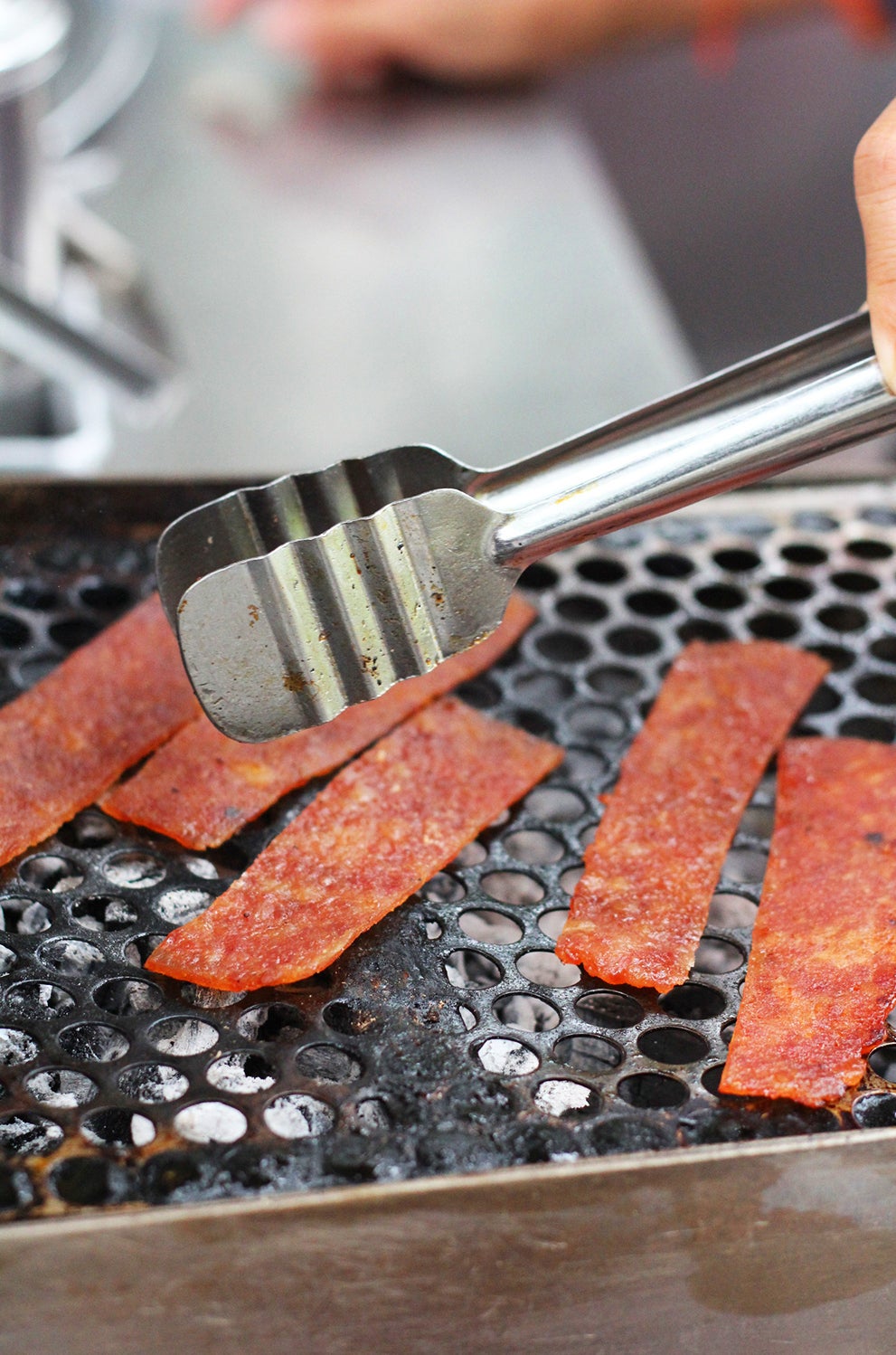
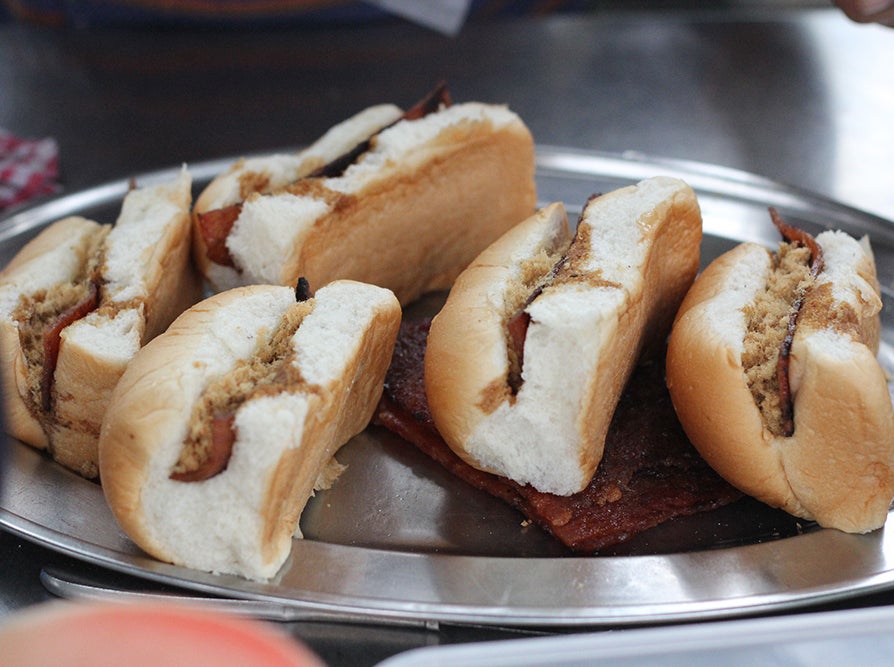
Chow Sow Peng, 56, was a housewife before she started selling here five years ago. Her signature snack is a bak kua bread, a fluffy, chewy, salty, sweet snack. She combines strips of bak kua — sweet Chinese pork jerky — and pork floss (fluffy, woollen dried pork that looks like something you could knit a sweater from) in a steamed hot-doggish bun, then drizzles a sweet homemade sauce over all.
Where: Jalan Pantai Jerjak 13 (see map above).
20. Otak Otak (Fish Cakes)
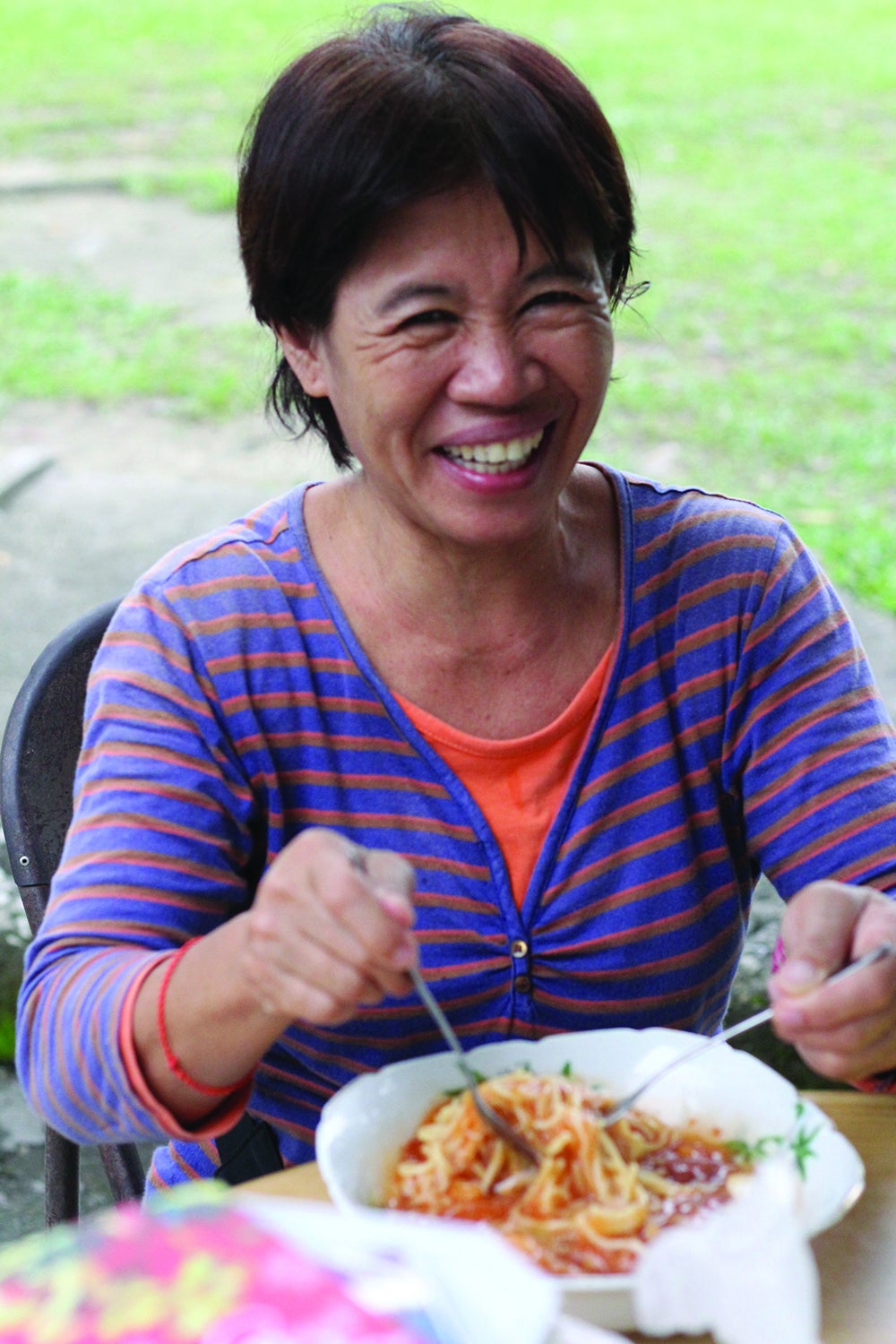

She also sells otak otak (“brain brain”), which is fish cake wrapped in banana leaf (not brains!).
There used to be, right next to this stall, a curry noodle stand belonging to her husband, Tony Ooi Hock Lai, 59. But curry noodles got to be too hard—there’s a lot to prep—and when her mother-in-law passed away and nobody was around to help, the two of them decided to give up the curry stall and focus on bak kua bread instead. They get all the ingredients from a market or from another distributor and don’t need to prepare anything from scratch except the sauce, which is made from a broth made of pork bones, plus dark Chinese soy sauce, regular soy sauce, sugar, and Ajinomoto (MSG).
21. Economy Bee Hoon (Rice Noodles in Black Sauce) and Mock Duck
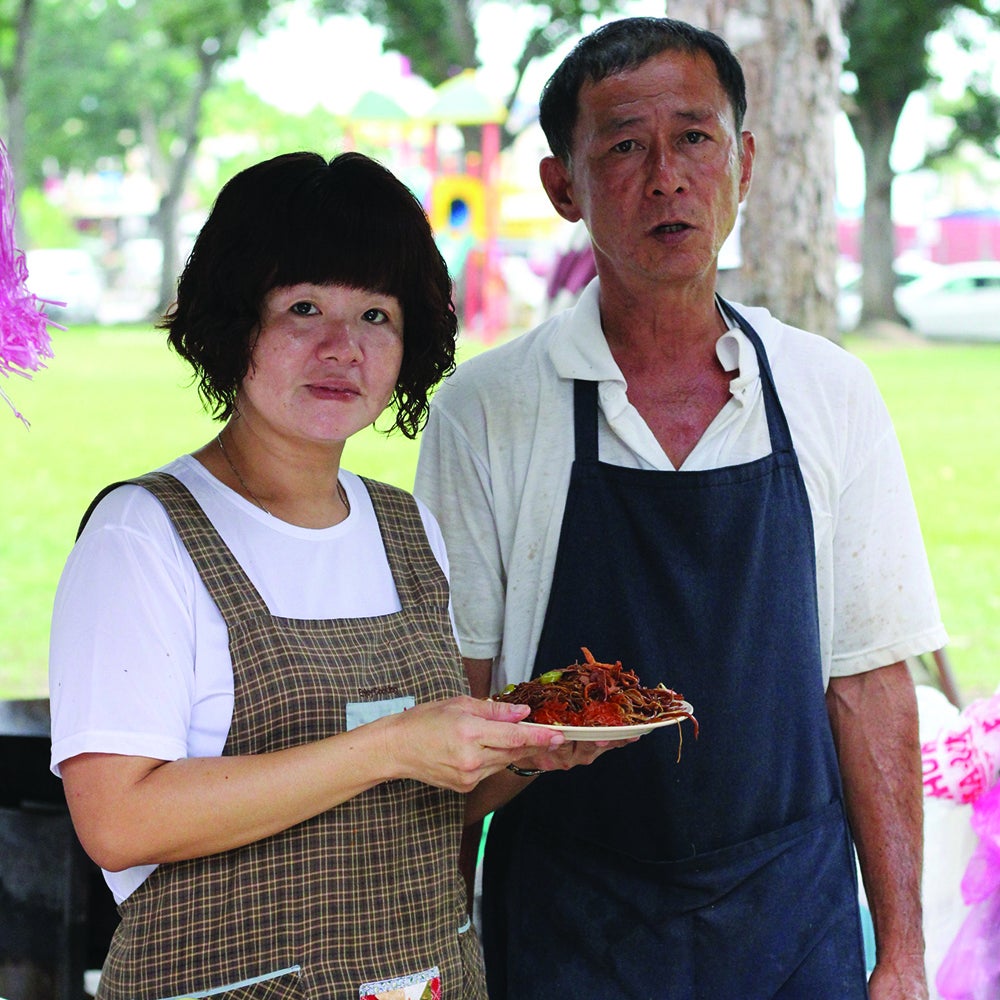
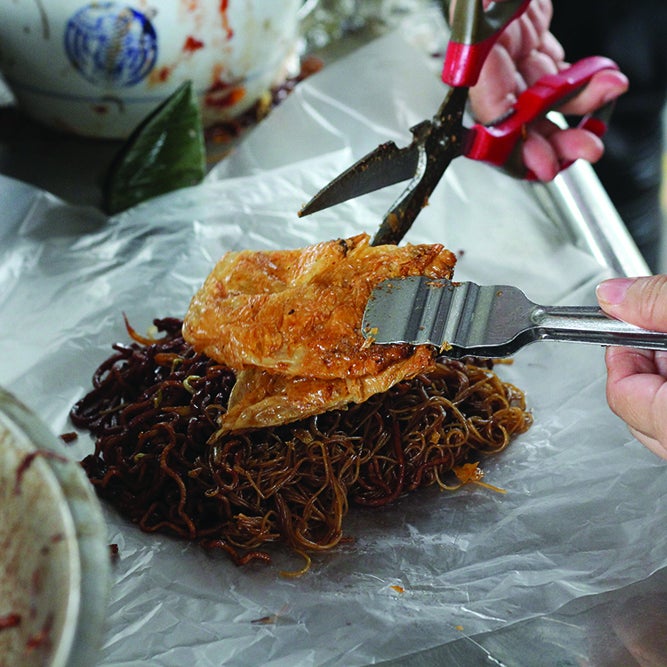
Serene Yeap Saw Phin, 45, and Tan Joon Ngin, 51, are a married couple who've been selling economy bee hoon (there's no meat, so it's really cheap, hence the "economy") together for eleven years. It's basically thin vermicelli (there's also a wider noodle for those who prefer it) cooked in a sweet black sauce, tossed with bean sprouts and sweet homemade pickled chilies. They sell from around six in the morning until they run out—usually early, around one or two—with him cooking and her plating and bagging. The wok's behind their stand and he'll cook up noodles, one big batch at a time. Into the wok go Ajinomoto crystals, ladles of mysterious black sauces, bean sprouts, crispy wonton skins, mock duck (made out of soy-something and cornstarch and a whiff of sesame), and sweet-and-sour chili sauce with the pickled chilies.
Where: Jalan Pantai Jerjak 13 (see map above).
22. Kuih Kosui (Glutinous Rice and Coconut Dessert)


Phin and Ngin also sell these bite-size green banana-leaf-wrapped things called kuih kosui: inside the banana leaf there’s a layer of pillowy glutinous rice dough wrapped around a filling of furry, shredded coconut stir-fried with brown sugar and pandan.
23. Mee Goreng (Soft Noodles Served with Lettuce)
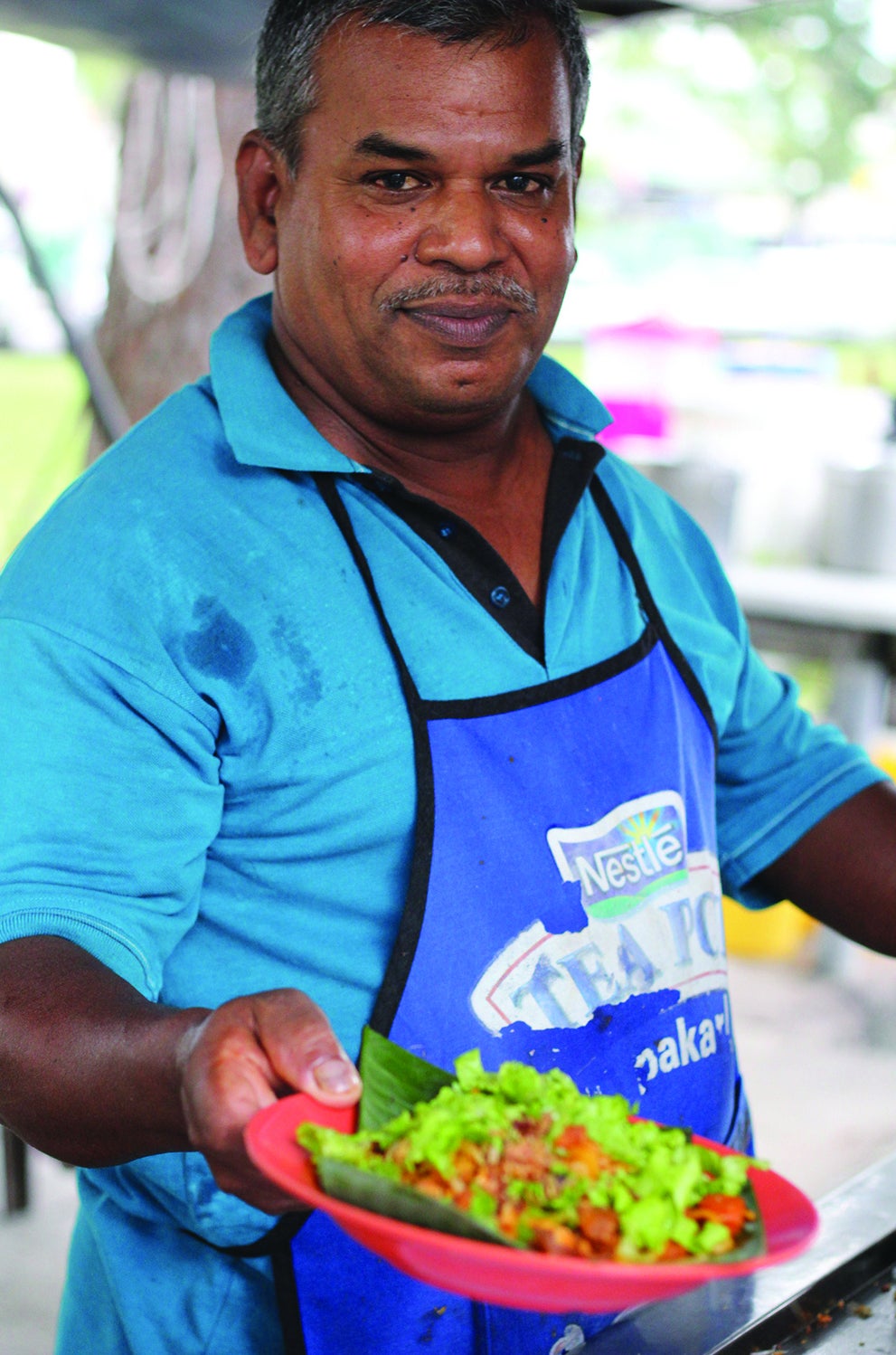

Mohamed Abu Backer Bin Abdul Rahim, 51, sells mee goreng, soft, spaghetti-size noodles wok-fried with lots of fixings. The noodles are garlicky and gingery and a little tomato-y, cooked with chili (it’s spicy but not overly so), potatoes, eggs, some bean sprouts, and other secret ingredients. Behind his stall are tables and chairs for customers to drink and eat. If you’re eating there, the noodles are served on a banana leaf and garnished with bits of green leaf lettuce and fried shallots.
Where: Jalan Pantai Jerjak 13 (see map above).
24. Economic Rice (Self-Serve Take-Out Buffet)
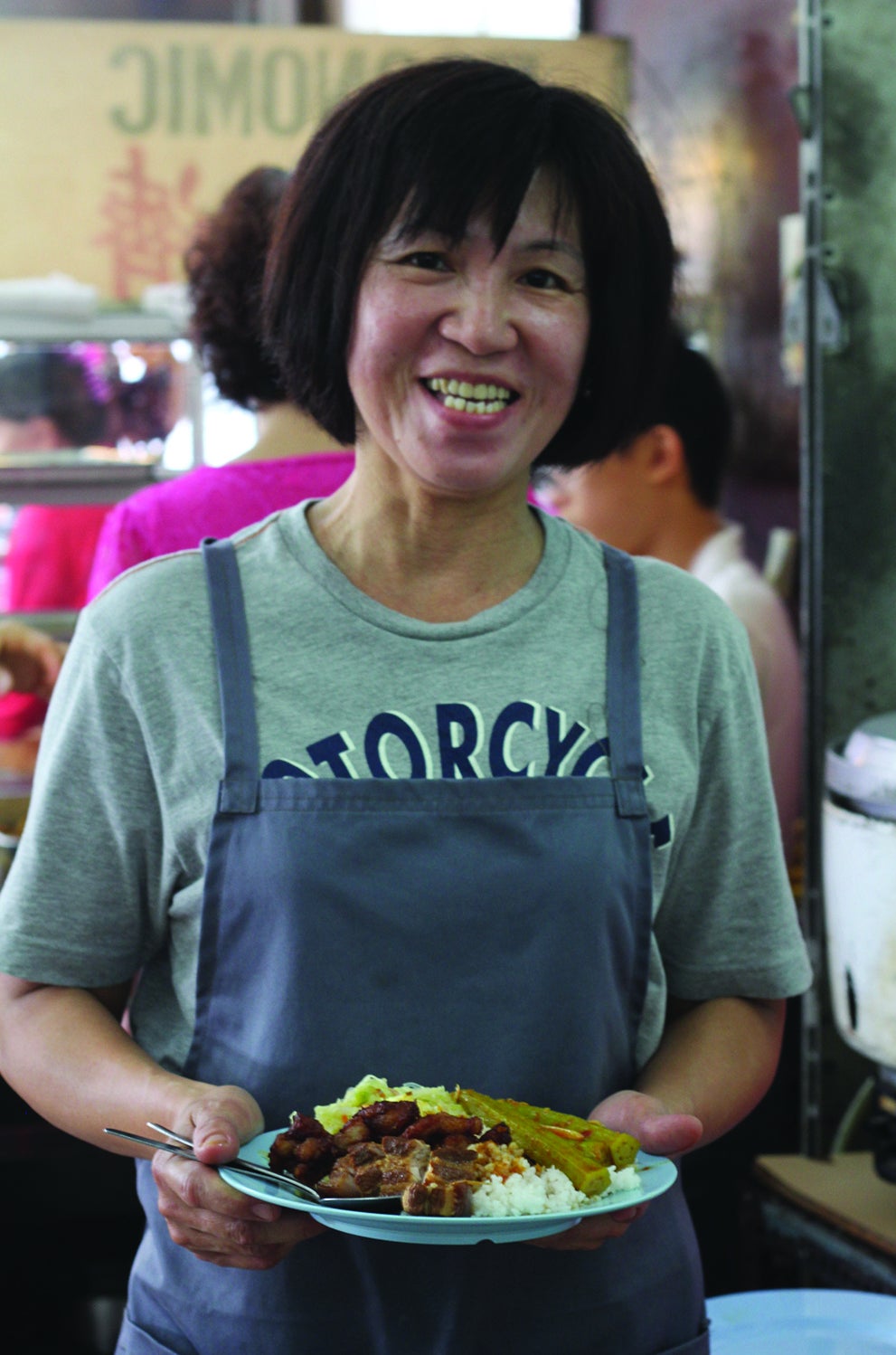


“Economic rice” is a self-serve stall. Koay Mooi Kee, 50, mans a rice cooker and oversees hotel pans of various vegetables and proteins—bok choy, curried and fried fish, fried chicken—that her husband, John Chin, 50, cooks in the kitchen in the back of the café. He’ll bring out trays of food every so often to replenish the supply. People bring their own containers and fill them up for lunch. They’re charged according to what they choose.
Where: Jalan Pantai Jerjak 13 (see map above).
25. Roast Chicken Rice

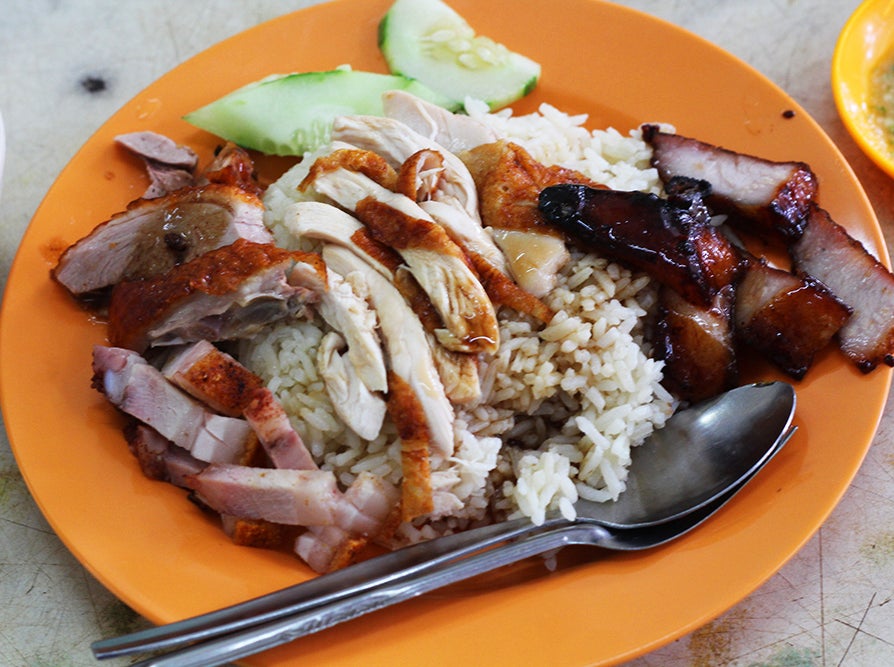
Roast chicken is the popular thing here: on weekends Cheng Siw Lee, 65, and her son, Poh Soon Ping, 44, sell thirty chickens a day (weekdays they’ll go through twenty-two). The chicken (and/or duck and/or pork) comes chopped up and drizzled with soy-saucey gravy—each piece of chicken has a little flap of crispy skin on it—and piled atop a mound of rice that’s fluffy and delicious because it’s been cooked in oil and butter. A little ginger scallion sauce and some cucumber slices ride alongside. Each order also comes with a soup that’s made from the carcasses of the roasted meats and boiled with mustard greens and chili—sour and spicy and nourishing.
Where: Jalan Pantai Jerjak 13 (see map above).
26. Char Hor Fun, Char Koay Kak (Noodle dishes)

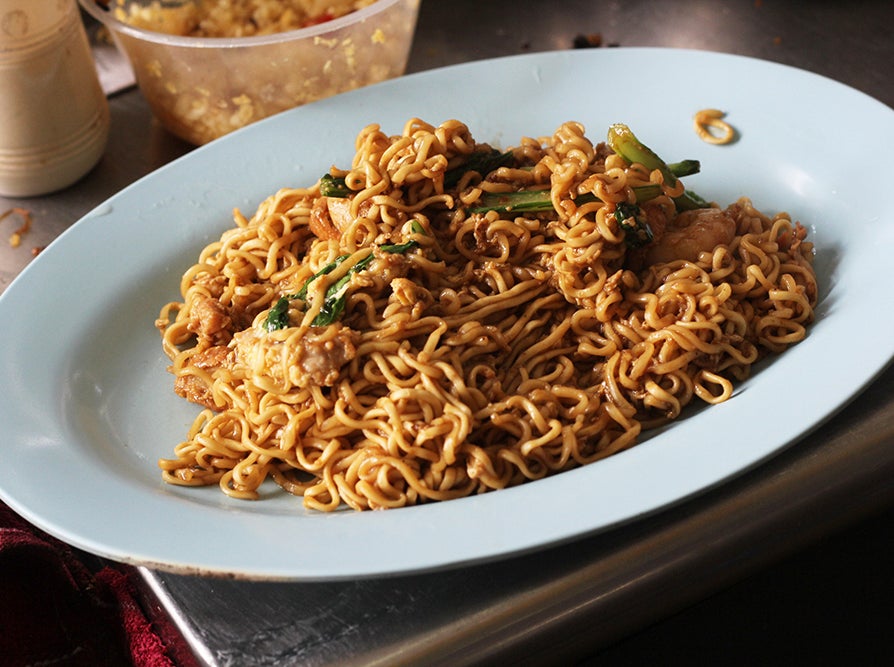
Ung Toon Keat, 52, sells salty and rich wok-fried comfort foods — fried rice and various kinds of fried noodles. He’s been doing this for five years now and was working construction before this. This stall belonged to his son before, but his son did if for half a year and quit.
Where: Jalan Pantai Jerjak 13 (see map above).
27. (More) Koay Teow Th'ng (Egg and Rice Noodles in Meaty Soup)

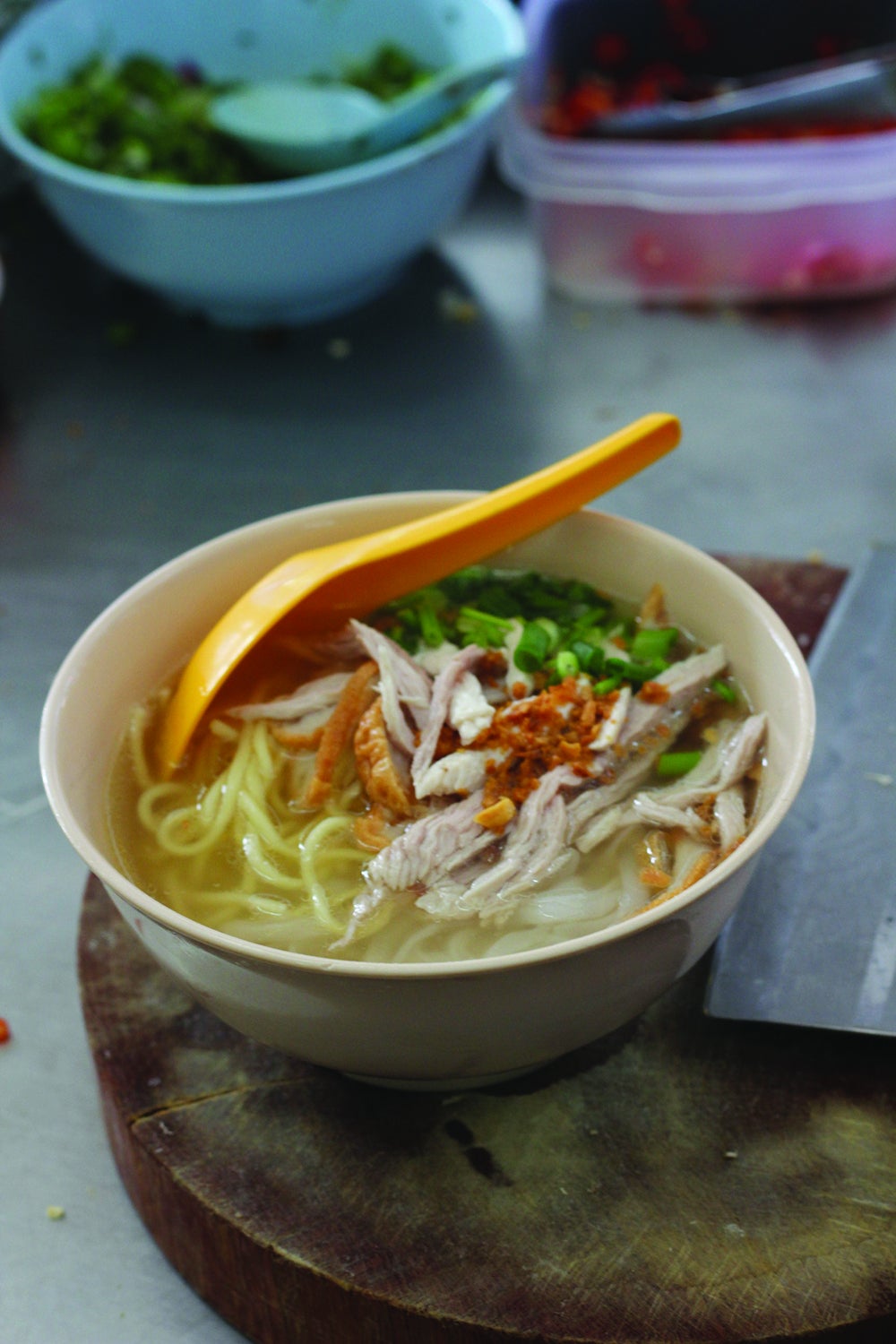
Ooi Sian Heang, 57, and her son Thor Chun Keat, 19, have been selling noodle soups together for two years. It’s a combo of silky rice and sturdier egg noodles in a chicken-and-pork broth with shreds of chicken, sliced fish cake, scallions, and a scattering of fried garlic on top.
Where: Jalan Pantai Jerjak 13 (see map above).
